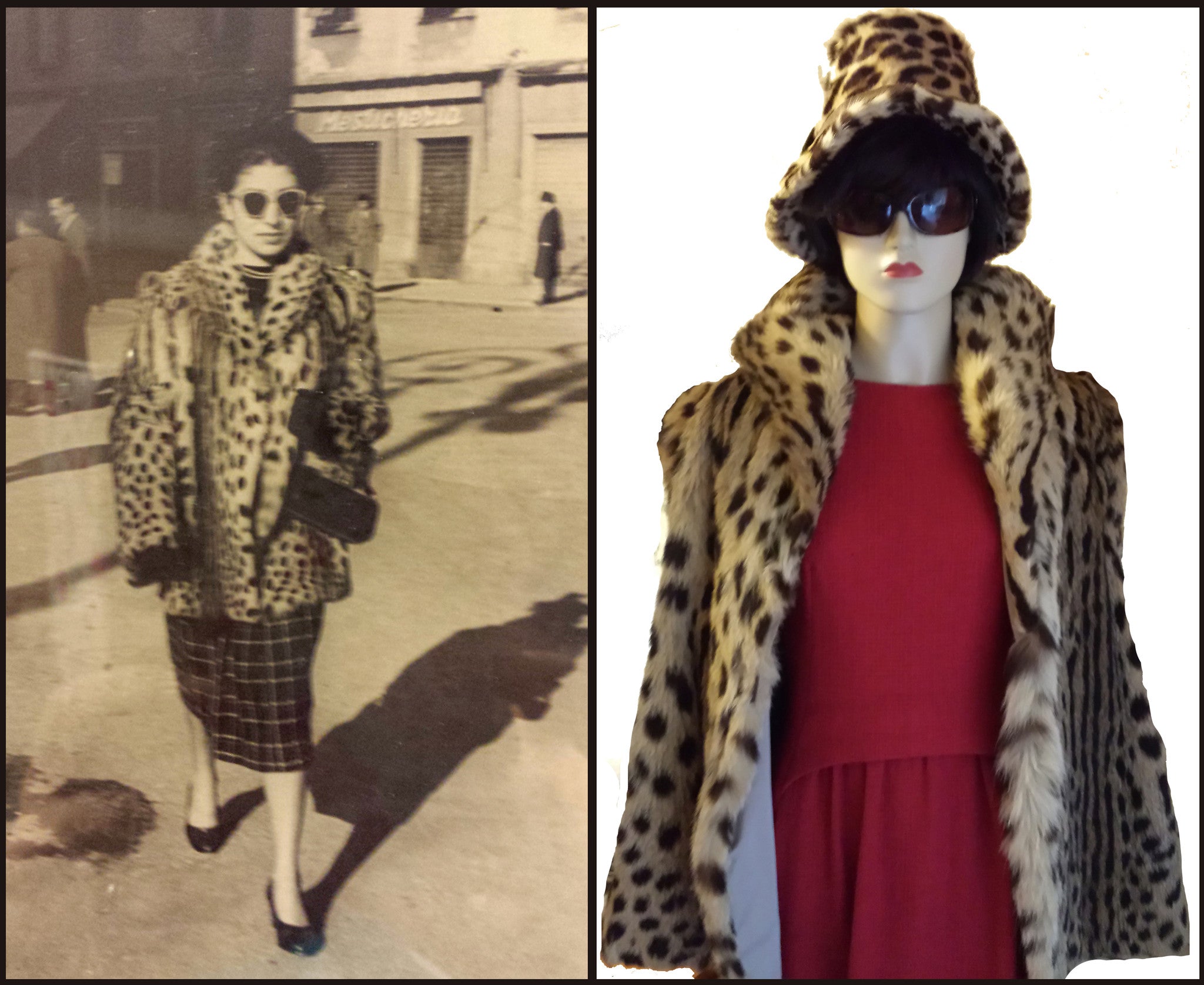
A Vintage Tribute: "L'armadio di Elia"
I met Maryelle on the film set of a mutual friend. Months later, she invited me to a memorial for her recently deceased mother Elia. Maryelle, with sister Christine and cousin Cinzia, had assembled a remarkable tribute, honoring Elia's life through a creative display of her beautiful, mostly home sewn, mid-century wardrobe.
Unable to attend the weekend-long open-house, I visited with Maryelle a few days after, and she was kind enough to grant me a private showing.

One of several displays.

Maryelle poses with her mom's suit.
 Elia is the center of attention at a party in Livorno, Italy (early 1950s)
Elia is the center of attention at a party in Livorno, Italy (early 1950s)

In the photo she's surrounded by suitors and wearing this polka-dot strapless dress. There's no evidence of where the strap attached, so maybe she just pinned it on. The material of the dress is almost like canvas.
BDV: I think it's raffia. And there's a coordinating velvet bolero. The clothes are beautifully made. When, where, and how did your mom learn to sew?
Maryelle: We don't know exactly who taught her. She told us she'd see things in magazines and say, "Oh, I can make that." At 16 she took a pattern-making class to learn to sew better. Once she'd learned how you're supposed to cut, she didn't need patterns anymore. And these clothes were clearly cut for her body.
BDV: She had a great figure. If you sew well, you can make what you know suits you, or what you prefer, ignoring trends. You can do the same thing by wearing vintage. Determine which eras' cuts flatter you, and stick with those.
Maryelle: She definitely repeated certain styles and colors. She knew what worked for her.
BDV: Tell us about this fur coat and hat.

Maryelle: The photograph is from 1952, and mom's wearing the coat, which she bought. She called it cheetah, but she knew that wasn't right. She couldn't think of the word in Italian. It's not leopard, either.
BDV: No, you're right. It's serval, a variety of African wild cat.
Maryelle: Aha! Well, a few years ago we took the coat to a local furrier to have it cleaned and repaired. Somehow they misunderstood what we wanted and they took off the sleeves! [gasps from BDV]
The hat is leopard, and she made it. We think she didn't measure right or something because it's too small to fit on a live person. And she didn't have a particularly small head.
BDV: I don't see any other hats. Perhaps this was her one attempt at millinery and it didn't work out. She kept it, though. It's tough to get rid of things you've made with your own hands. Show us some more.
Maryelle: Here are more dresses from before she was married. We don't know who the guy is she's dancing with, but it's November 1954.

And then there's this one, which is unfinished. It's still got the basting stitches. But there's no lining, no boning. We don't know why she made this one and why she didn't finish it.

BDV: Did she think she might get around to it eventually? I can just imagine my piles of unfinished projects 40 years from now. [laughter]
Maryelle: She made me a dress for a formal in high school. The pattern picture had straps. I said I didn't want straps. She said it would need boning if we left off the straps. But I didn't want boning because at the time that was an old-fashioned thing. So she made it without the boning and she was totally right. I spent the whole night doing this [tugs at her imaginary bodice].
BDV: Moms are usually right, maddeningly enough.
Maryelle: In 1955, mom emigrated to the United States. In 1957 in New York City she met the man who'd be my father. They flew to New Orleans to get married. She wore this dress and coat.


He was a captain at the time, and they got invited to a gathering at the officer's club in Pearl Harbor. She cut this red dress out in the morning, no pattern, then sewed it and wore it to dinner that night.

BDV: Dreamy. That stand-away bodice treatment is called a "crumb-catcher." Again, the dress is beautifully made. She's finished all the edges of the interior darts with overcast stitching. And there's a matching shawl.
Maryelle: You could wear these Hawaiian styles today. No one would even know they're vintage.
BDV: Absolutely. I actually wrote a blog post a while back about them being easy to wear and universally flattering.
Maryelle: After Pearl Harbor, mom and dad moved to Fort Richie, Maryland. My mother continued making clothes, but not as much, so most of the items on display are from before then.
BDV: This mauve satin wiggle dress is gorgeous. It's silk, and so exquisitely cut, with multiple hip darts front and back to hug her curves, and this pleated detail at the back of the skirt.

Maryelle: It has a detached single strap. We're not sure how it went.
BDV: I suspect it went diagonally across the front. That style had a moment in the 50s. I like it better without the strap, as you've displayed it.
This next dress is interesting. The cut is reminiscent of the late 1910s, with its delicate feel and long layered skirt. And she really liked this appliqued tulle fabric. I wonder if she acquired it in Italy. Maybe it was a specialty of the region?

Maryelle: She did make a lot of dresses with this type of fabric and I don't think she did the applique work herself. The unfinished fruit dress uses this same sort of material.
Maryelle: Here's one she made in 1959. In the first [b&w] photo she's 33. And here she is wearing it again, at 48.

BDV: This red wool dress looks to be the most recent of the bunch. I love the curved front.

Maryelle: It's got the mod feel of the mid-1960s. We're not sure when she made it, but the photo we have is from 1967.
BDV: It's remarkable how much of your mom's mid-century clothing you have. And we've only described a portion of what's on display here.
Maryelle: Yes, but there was much more. A lot was lost over time. We have pictures, but the clothes are gone. Sometimes you don't realize their value -- if not monetary, then historical, and sentimental.
BDV: You'd be fortunate to have a few pieces, but there's enough here for people who never knew Elia to get a sense of her style, personality, and talent. The photos of her wearing them provide an intimate glimpse into her life. It's wonderful. I thank you for sharing your mom's story with us through her marvelous wardrobe. It's a moving tribute.
Maryelle: Thanks for coming. We're glad people could learn about her and see the clothes. Mom wasn't religious so we didn't have a Mass card. Instead, we listed the main places she lived for any length of time.

"To every bird his nest is beautiful."


Elia with Teresa, Poppi, and Dorris in 1946

Comments
Let me just wipe away a few tears.
My condolences to this remarkable woman’s family. The talent this woman had is just breathtaking. What a gift they have shared. Wow!
One doesn’t see talent and beauty like this everyday. This is art…..
Fascinating, what a beautiful talented lady.
I love how she just whipped up that red dress in one day.
Im Italian and I really like this story!!
Liza, thank you for this beautiful article. I am truly teary-eyed over it. Of course I knew all of what you wrote but it is a lot different seeing someone else say it vs. my thinking it. I truly appreciate the knowledge you shared over some of her things, the official name or origin of which we did not know – fabrics, fur types, the maker of her little gold lamé purse. (Liza saw the person and immediately knew who the maker was, and opened it to show us the hidden label proving she knew exactly what she was talking about!) Thank you so much for being part of her memorial.
Hi, a friend sent me this article, since I am a dressmaker/ costume designer for a legitimate theatre company.
I of course design my own clothes. My favorite eras are 30’s-50’s. I often use them in our plays that require period styles. I Have in the past,given away clothes that I made over the years. I still have a very crowded closet however. But these pictures have me rethinking keeping things to leave for my grand daughter in law, I am 78 And size 6 as is she. She loves my clothes and is always " borrowing my stuff. She wears them well, as they suit her figure.
My friend who sent me this article, though much younger shares my appreciation for beautiful fine vintage clothing. This is an art form that has been obscured by mass production.
My skills and education along with a natural artistic talent was a normal aspect of upbringing. My my mother, her mother and “sew” on.
Fashion is time travel. A beautiful expression of history.
Thankfully, Aalsa Lee
